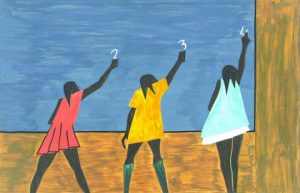
Jacob Lawrence Great Migration
In the nineteenth century, both before and after the Civil War, most African Americans lived in the rural South. Cincinnati had a relatively high African American population for a Northern city at about 5% in the early twentieth century, and the population grew by nearly a third in the first decade of that century to nearly 20,000 in 1910. The West End downtown was the most common neighborhood for African Americans, but even there the overwhelming majority of residents were white.
Beginning in 1916, a huge population shift took place. African Americans moved to industrial cities in the North, beginning what is known as the “Great Migration.” That term is now usually employed to describe the period from 1910-1970, although the most striking spikes came during the years of the first and second world wars. W. E. B. DuBois estimated in June, 1917, that “about 250,000 colored workmen have come North” in a summary of an NAACP study published in The Crisis. Dubois cited three causes: agriculture failures in the south owing to widespread flooding and a boll weevil infestation in the cotton crop fields; a huge demand for labor in the railroad, food-packing, steel and automobile industries; and outbreaks of mob violence in some Southern states. Some of the labor shortage was owing to what was then known as “The European War” (later called World War I), which simultaneously restricted the supply of immigrant labor, stimulated advanced industries owing to the lack of European competition, and diverted civilian laborers to the military.
Cincinnati in general, and Walnut Hills in particular, saw a huge increase in African American population, especially during the peak years of 1916-1919. The migration cause disruption in the social fabric of the cities in the Ohio River Valley and in industrial northern cities like Detroit and Chicago. Cincinnati managed the migration better, and perhaps consequently avoided the worst of the violence directed toward the immigrants – St. Louis, Detroit and Chicago all experienced white mob terrorism, in those days called “race riots.”
 Frederick Douglass School was at the center of the assimilation of the southern immigrants into the stable Black culture in Walnut Hills. A pamphlet from 1920 noted “The great increase in enrollment in the last few years is almost entirely due to the great influx of Southern migrants. Opportunity Classes, averaging about 25 pupils per class, have been organized to meet the needs of such of these children as are retarded.” Not only did the school accommodate children, many of whom had little education at all when they arrived; Douglass also offered evening classes for basic adult education. Moreover, many of the teachers at Douglass played key roles in other institutions that offered social support: James Robinson became the Executive Secretary of the Negro Civic Welfare Committee of Cincinnati’s Council of Social Agencies. Sarah Gibson Jones and Grace Slade played key roles in the Cincinnati Federation of Colored Women’s Clubs, each club devoting itself to a charitable institution in the community. Grace Slade served on the board of the Negro YWCA in the west end. Others were involved in the many Black Churches in Walnut Hills.
Frederick Douglass School was at the center of the assimilation of the southern immigrants into the stable Black culture in Walnut Hills. A pamphlet from 1920 noted “The great increase in enrollment in the last few years is almost entirely due to the great influx of Southern migrants. Opportunity Classes, averaging about 25 pupils per class, have been organized to meet the needs of such of these children as are retarded.” Not only did the school accommodate children, many of whom had little education at all when they arrived; Douglass also offered evening classes for basic adult education. Moreover, many of the teachers at Douglass played key roles in other institutions that offered social support: James Robinson became the Executive Secretary of the Negro Civic Welfare Committee of Cincinnati’s Council of Social Agencies. Sarah Gibson Jones and Grace Slade played key roles in the Cincinnati Federation of Colored Women’s Clubs, each club devoting itself to a charitable institution in the community. Grace Slade served on the board of the Negro YWCA in the west end. Others were involved in the many Black Churches in Walnut Hills.
The best introduction to the great migration for children, and perhaps for adults as well, is the Great Migration series of painting by the African American artist Jacob Lawrence. Some of the students at Frederick Douglass have been studying this in art class. To get a flavor of the series, see the web site at The Phillips Collection.